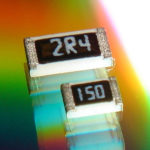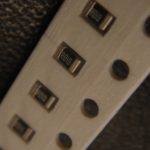Stackpole’s CSSK3637 is a four-terminal shunt that provides very low resistance values which have been expanded to 0.5 to 6 milliohms, in tolerances as low as 0.5% and TCR of 50 ppm. In addition, this all-metal shunt has an operating temperature up to 170C, providing excellent stability for a wide range of end products. The […]
stackpole
SMD zero-ohm jumpers handle over 70 A
Zero-ohm jumpers are widely used in all types of electronic circuits for a wide range of markets and end products. They make circuitry routing easier and simplify manufacturability. However, jumper requirements for higher current levels frequently exceed the capability of general-purpose jumpers, and even some jumpers are classified by the manufacturer as “high current.” Stackpole’s […]
High-current shunt resistors offer a 5-W power rating
Modern electronics utilize current sense resistors for portable power management. As larger and more powerful devices become portable, higher currents and higher power ratings become critical, however, space for any portable electrical device must always be conserved. The HCSM2818 from Stackpole offers a 5-watt continuous power rating to maximize power handling in a given PCB […]
Current-sensing foil-on-ceramic resistors sport 2 milliohm resistance
High efficiency in consumer electronics has become increasingly important. For portable electronics, this means lower resistance values on current sense resistors for battery and power management. Stackpole’s CSRF series is a foil on ceramic carrier chip resistor that is designed for these applications. The CSRF2512 is now available in resistance values down to 2 milliohms. […]
Ultra-high power thick-film chip resistors offer PCB space savings
Today’s electronics devices push the envelope for smaller designs and greater functionality. Stackpole’s RMCP-UP is a high-power thick film chip resistor with very high power ratings for each case size, ranging from 0.2W rated 0402 sizes to 3W 2512 size. These elevated power ratings allow design engineers to use smaller chip resistors to free up […]
High-current jumpers handle up to 7 A
Electronic circuits frequently require zero-ohm jumpers for ease of manufacture or to make trace routing easier. Some of these applications require current handling that exceeds the capabilities of general-purpose or high current jumpers. Stackpole’s HCJ series offers more than double the current rating of comparable high current jumpers. The HCJ current ratings range from 5.8A for […]
Current shunt resistors handle 5 W in space-efficient 2818 package
Power management applications for frequency converters, inverters, and hybrid power modules demand high power with environmental and electrical stability. While high power shunt resistors for current sensing are becoming more readily available, there is normally a tradeoff between high power and stable performance to achieve the higher power rating. Stackpole’s HCSM utilizes a metal element and […]
All-metal current-sense chip resistors feature 1-W power rating
IoT and Robotics require high efficiency and small size to maximize functionality. For current sensing, this means high power in small case sizes and low resistance values. The CSSH0805 from Stackpole is an all-metal chip resistor with a 1W power rating, resistance values down to 0.5 milliohms, and TCR ranging from 50 ppm to 100 […]
Ultra-precision current-sense chips feature resistance range to 80 mΩ
The CSSH2512 from Stackpole is an all metal current sense chip resistor capable of precision tolerances as low as 0.5% and TCR as low as 15 ppm. The resistance range for the 3-W 2512 size chip has been expanded and now spans from 0.5 mΩ up to 80 mΩ. The high precision combined with the […]
Keys to understanding resistor specs
The specification process for resistors involves more than just allowing for tolerance bands. Voltage, power, and temperature ratings can interact in ways that can degrade circuit reliability. Kory Schroeder, Stackpole Electronics, Inc. Although not a complex component, resistors have specifications that can be confusing, misleading, and misinterpreted. When specifying performance qualities, it is important to […]











